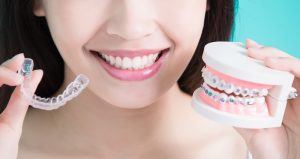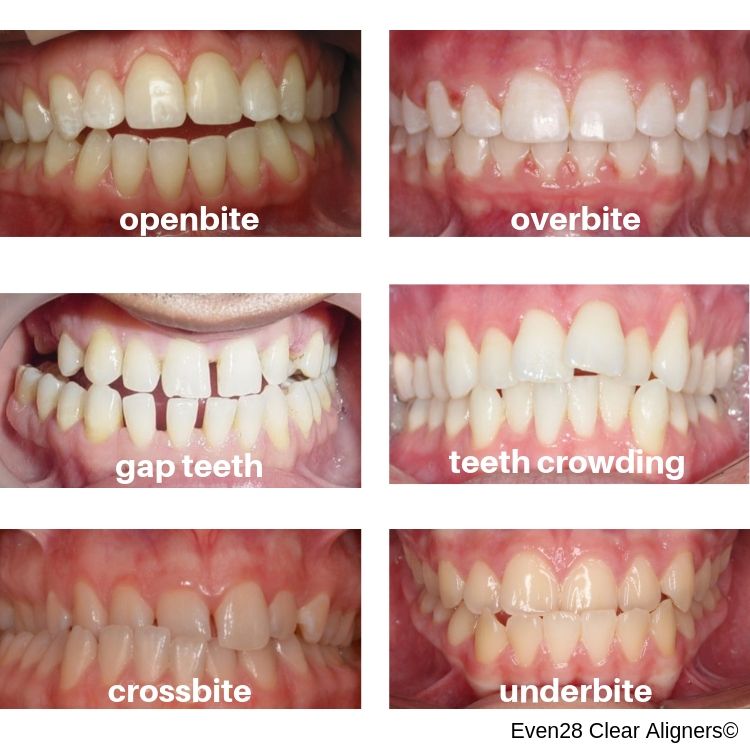4 Questions to help you decide if you qualify for clear aligners

If you’re looking for ways to straighten your smile, chances are you’re trying to decide between clear aligners and braces. Clear aligners are a more modern alternative to braces. Clear aligners are comfortable, removable, and nearly invisible in your mouth. You can remove your aligners to eat, drink, and clean your teeth. In contrast, braces hurt more, they cause more bruising, and they can never be removed from your teeth. As a result, more and more people are choosing clear aligners to straighten their smile. Before you get too excited about clear aligners, you need to make sure that you’re a candidate. Not everyone qualifies for clear aligner therapy. Take the quiz below to see how likely you are to qualify for clear aligner treatment:
Online clear aligner assessment quiz
Quiz explanations:
Complete the quiz above to get an idea of how likely you are to qualify for clear aligner treatment. The quiz yields a percentage that shows how likely you are to qualify for clear aligners:
- A high score means that you’re likely to be a good candidate for clear aligners
- A low score means you need to go with braces instead of clear aligners
The quiz above is for entertainment purposes and it’s not intended to replace medical advice. You must consult with your dentist or orthodontist to straighten your smile. With that in mind, let’s take a closer look to better understand what are the qualifications for clear aligner therapy:
Questions #1: Your orthodontic condition
Certain orthodontic conditions are easily fixed with clear aligners. Others, not so much. Let’s discuss these different orthodontic conditions to see which ones are good candidates for clear aligners and which ones require braces. Browse through the following photos to see which orthodontic condition best describes your condition:
 An example of different orthodontic conditions: Some are good candidates for clear aligner therapy while others generally require braces.
An example of different orthodontic conditions: Some are good candidates for clear aligner therapy while others generally require braces.
Gap teeth (spacing)
Teeth crowding (crooked teeth)
Overbite
Open bite
Open bite is when you close your mouth and there’s a gap between your front teeth in the horizontal space. Ideally, your front teeth are supposed to overlap with the lower ones and there shouldn’t be such a gap. Some open bite cases qualify for clear aligner treatment, but many don’t. We recommended you only fix open bites using dentist-delivered clear aligner programs like Invisalign® or ClearCorrect™. Periodic dentist supervision is required to make sure that everything goes as planned. Advanced open bite conditions usually don’t qualify for clear aligner treatment and require braces instead. To learn more about how you can fix open bites using clear aligners click here.
Underbite
Crossbite
Questions #2: Severity of your orthodontic condition
The next most important factor is the severity of your orthodontic condition. The milder your orthodontic condition, the more likely you are to qualify for clear aligners. For example, a small overbite can usually be fixed with clear aligners. On the opposite hand, fixing a severe overbite usually requires braces. The more advanced your orthodontic condition, the less likely you are to qualify for clear aligner treatment.
Questions #3: Your bite relationship
Your bite refers to how your back teeth come into contact with one another when you close your mouth. Here’s what a good and bad bite relationship looks like:
“Good” bite relationship
A good bite relationship is when all of your back teeth come into contact when you close your mouth. Having a good bite relationship helps spread bite forces among your back teeth. This protects your teeth and jaw against chewing forces and is very important to the long-term health of your teeth.
“Poor” bite relationship
A poor bite relationship is when your back teeth don’t make proper contact when your mouth is closed. Having a poor bite relationship causes your back teeth to become overstressed. This increases the likelihood of your brack teeth fracturing and causes your front teeth to chip. Having a poor bite relationship can also trigger headaches, TMJ problems, and cause other head and neck related issues.
Bite correction is not an easy task! Minor bite corrections can be accomplished using dentist-delivered clear aligner programs like Invisalign® or ClearCorrect™. Fixing more complex bite relationships is best achieved using braces.
Questions #4: Previous orthodontic history
We have good news for those of you who had orthodontic treatment in the past: it’s much easier to straighten your teeth if you’ve already had braces or aligners before. Most patients who have had braces don’t want to wear brackets and wires all over again. Luckily, clear aligners are the perfect solution. Clear aligner therapy can fix most orthodontic relapse cases. This means that you don’t have to wear braces a second time and can go with clear aligners instead.
Find a clear aligner provider near you today!
Now that you have a better idea of whether or not you qualify for clear aligners, it’s time to fix your smile! Straightening your smile with clear aligners is easier than you imagine. If you scored really high on the quiz, you can straighten your smile with a remote clear aligner program like Smile Direct Club™ or Candid Co.™ If you scored so-so, then you need to find a local dentist or orthodontist to fix your smile. Try using our dentist Search Engine to browse nearby dentists and find one that offers clear aligners to help you straighten your smile:
FIND A CLEAR ALIGNER PROVIDER NEAR YOU